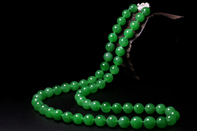During the 1980s, Hong Kong’s jadeite market was flooded with a large influx of chemically treated, acid bleached or resin filled jadeite (commonly known in the industry as Type B jadeite). Even when using standard gem identification instruments on Type B jadeite, it is very difficult to distinguish Type B jadeite (chemically treated) from Type A jadeite (100% natural jadeite). Since then, consumer confidence has been hit hard and they find it more difficult to trust sellers. Experts have found more ways to tell the differences between natural and treated jadeite. For example, identifyingcertain aspects using a magnifying glass to examine the characteristic inclusions such as internal textures, colour patterns and transparency levels whether they seem natural or treated, or whether the jadeite makes a nice crisp sound when you gently tap against it. All these techniques mentioned above were actually widely adopted within the industry but none were proven to be scientific and there was no other method to confirm 100% whether a specimen of jadeite has been treated or not.
So, how to classify different types of jadeite? There are in general 4 types of jadeites circulating in the market, namely Type A, B, C and B&C jadeite. Only Type A jadeite is regarded as natural jadeite, whilst the others are regarded as treated jadeites.
Type A (Natural jadeite or “Fei Cui”)
Refers to natural jadeite which has not been subjected to any form of chemical treatment.
Note: To polish natural jadeite with colourless wax, which does not cause any damage to the crystalline structure of the jadeite, shall not be classified as a chemical treatment.
Type B (Chemically treated and resin impregnated jadeite)
Refers to jadeite which has been chemically treated and resin impregnated.
Type C (Dyed jadeite)
Refers to jadeite which has been treated with dye.
Type B+C (Chemically treated, resin impregnated and dyed jadeite)
Refers to jadeite which has been chemically treated, resin impregnated and dyed.
Therefore, the Hong Kong Jewellery & Jade Manufacturers Association (formerly known as the Hong Kong Jade and Stone Manufacturers Association) established the Hong Kong Jade & Stone Laboratory Ltd. (HKJSL) in 1993. Equipped with the most advanced instrumentation, including an infra-red spectrometer, the experienced gemmologists of HKJSL can test jadeite accurately and issue authenticated certificates to the public.
Hong Kong has a well-established jadeite jades and gems identification and grading system.
After its creation, HKJSL has been using strict procedures, impartiality and objectivity to test different grades of jadeite. Certain issues and certificates are contained for each grade, making sure no treated jadeite get through.
In order to provide a more comprehensive testing identification service, HKJSL expanded its gemstone testing identification service in 1997 to include rubies, sapphires, emeralds and alexandrites etc. This service aims to ascertain whether a gemstone is natural, synthetic or an imitation stone, and whether it has been treated, which is important for both the consumers and traders.
HKJSL passed the assessment of the Hong Kong Accreditation Service in 2005 and was officially recognised as the certified accredited laboratory by the Government of the Hong Kong Special Administrative Region Hong Kong SAR. This was a huge progress for the laboratory and then in 2012, it was recognised by the International Laboratory Accreditation Cooperation Group (ILAC) and given the Mutual Recognition Arrangement (MRA) mark.
HKJSL is a joint venture under Hong Kong Jewellery and Jadeite Manufacturers Association and Hong Kong Jade Merchants Association, both being non-profit making organisations. Since the two associations are not directly involved in any trade transactions, testing and certification services are carried out in an independent and unbiased manner.
































